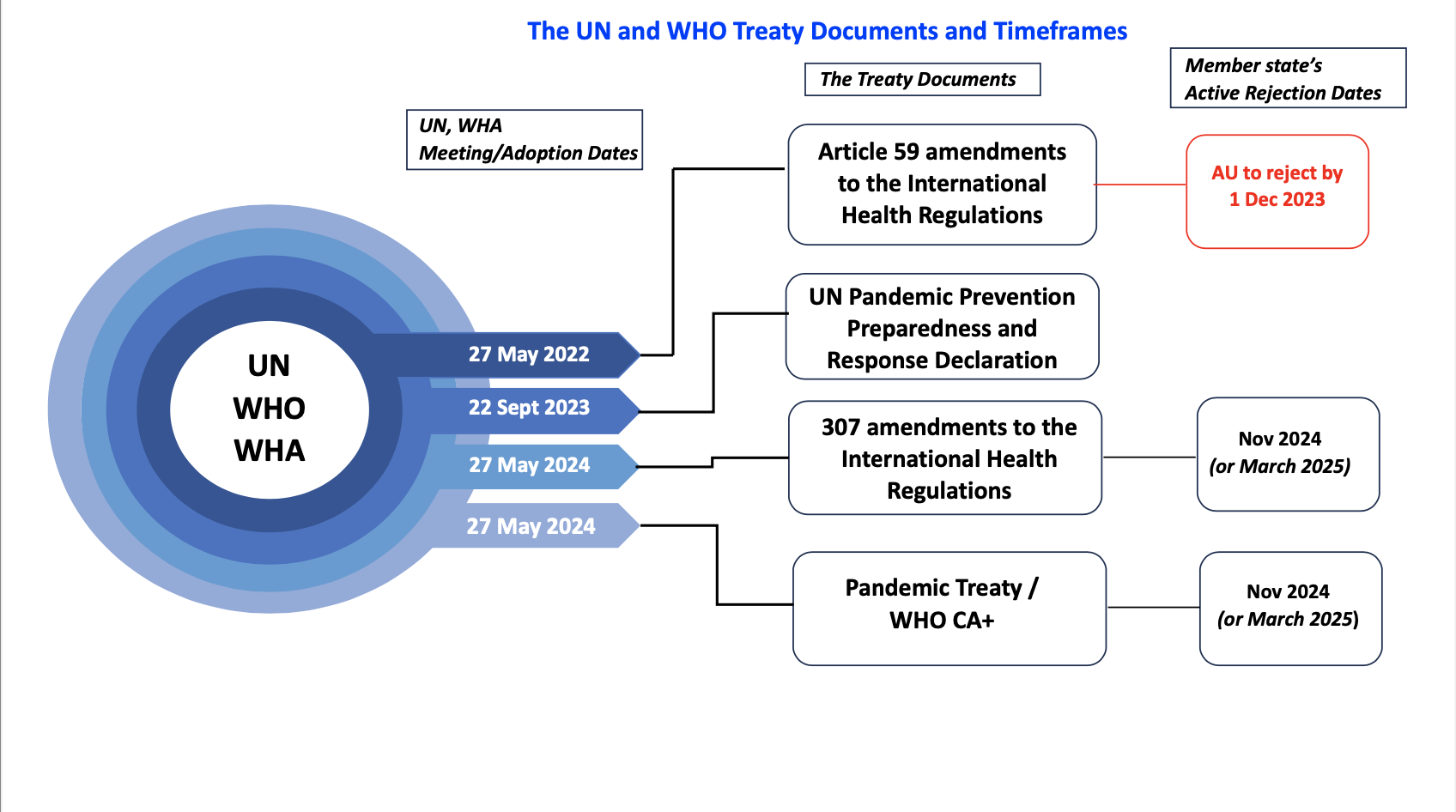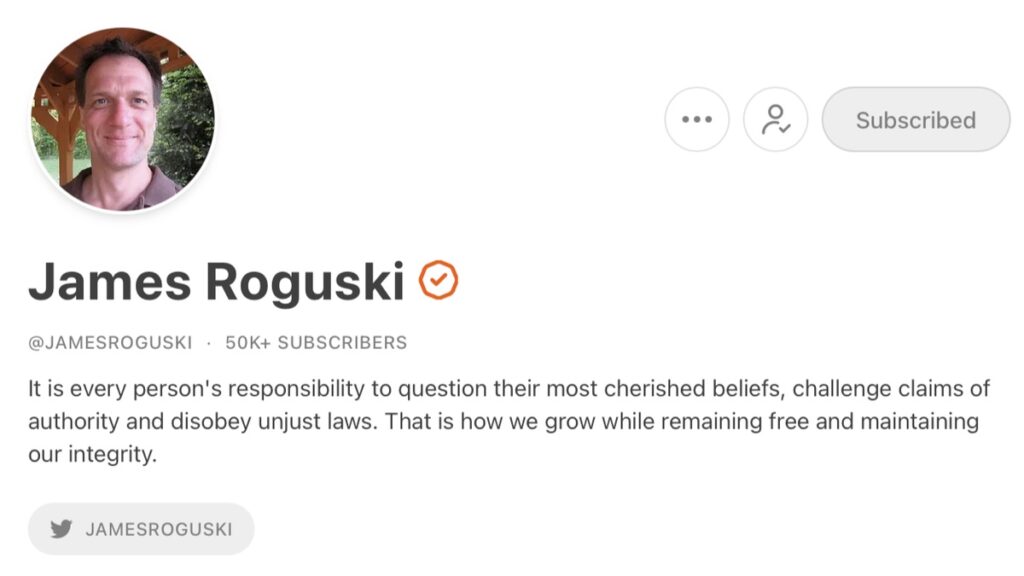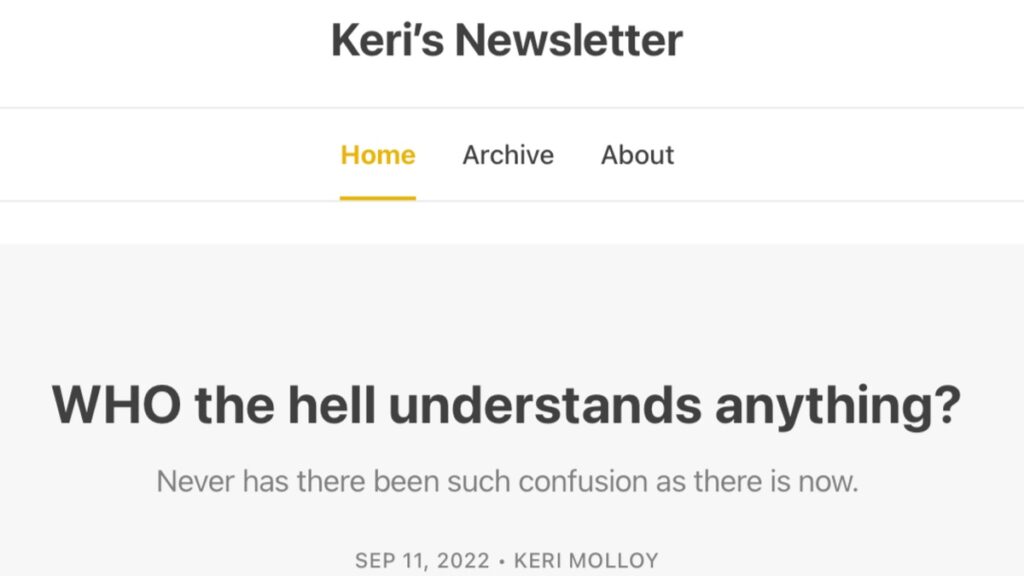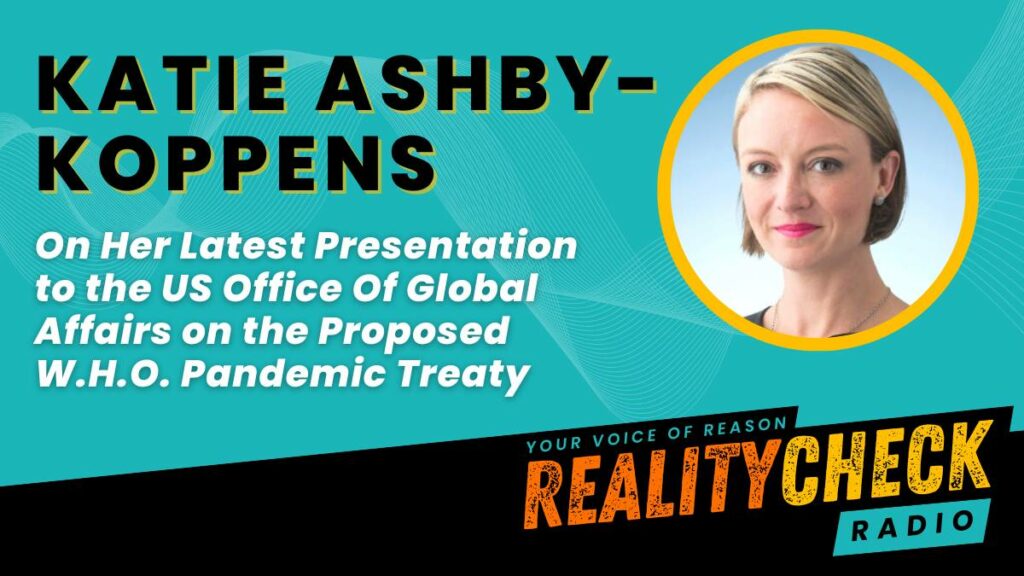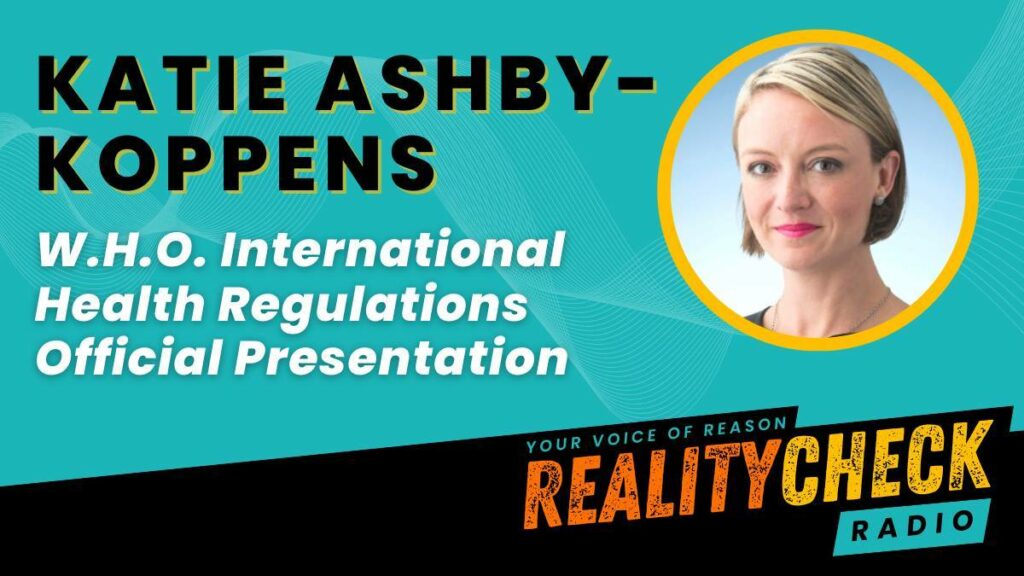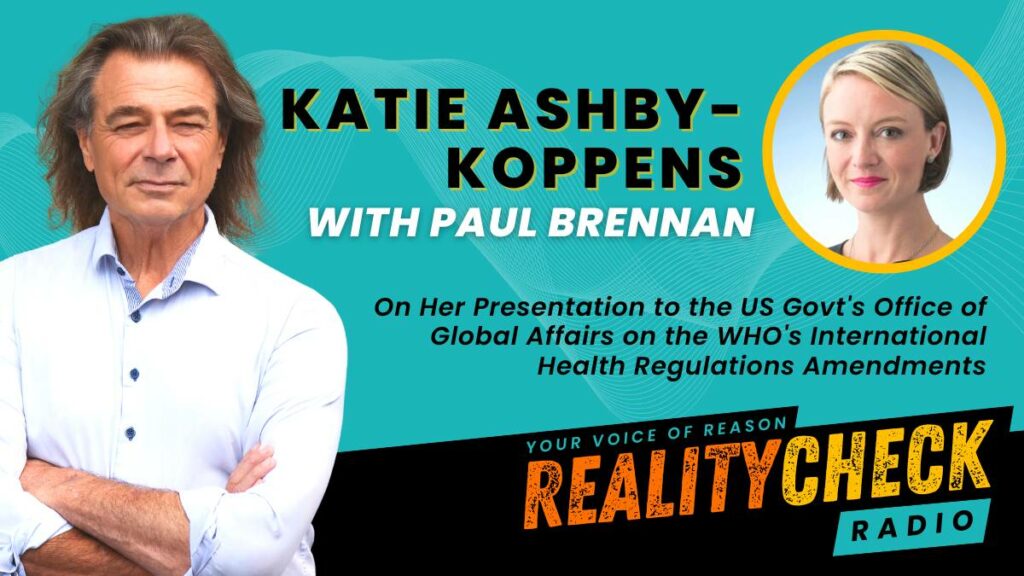WHO/IHR

The alarming Political Declaration, Amendments to the International Health Regulations and the new Pandemic Treaty/WHO CA+ and what they will mean for YOU!
The WHO is the World Health Organisation, an agency of the United Nations (UN) responsible for international public health.
Both organisations are currently preparing 4 documents that purport to be treaties all in the name of health and future pandemics. These documents are being drafted under urgency, behind closed doors, by unelected officials. They are a mixture of an update of previous regulations, which New Zealand is bound to, and some new treaties, the 4 documents are:
1. The new UN’s Political Declaration of the United Nations General Assembly Pandemic, Prevention, Preparedness and Response Manifesto – Zero Draft (UN PPPR Declaration)
2. Article 59 amendments to the International Health Regulations (Article 59 IHRAs)
3. 307 proposed amendments to the the International Health Regulations (307 IHRAs)
4. A new pandemic accord called the Pandemic Treaty or WHO CA+ (WHO CA+)
The 4 treaties will hand the WHO the authority to make binding directions on how a country is required to respond to a potential public health emergency (not an actual one). The WHO will be able to order measures including significant financial contributions from individual Member States, censor scientific debate, order lockdowns, restrict travel, force medical examinations and mandatory vaccinations, all in the name of health.
Whatever your views of the Covid pandemic, we can all agree that before running headlong into new and more rules, that the more appropriate step for the UN and the WHO would be to stop and reflect, hold hearings and make findings on what worked, what didn’t and what could have been done differently.
Timeframes are running now, and in order to stop their progress Australia needs to actively reject them by specific dates, otherwise the treaties become binding on Australia.
Upcoming important dates:
1 December 2023: NZ needs to have rejected or reserved the Article 59 IHRAs, that reduce timeframes to consider, reject and implement new changes to the IHRs ie the 307 IHRAs
15 January 2024: the Working Group must deliver the 307 IHRAs to the Director General of the WHO to submit 4 months before the next World Health Assembly scheduled end of May 2024
End May 2024: Seventy-seventh WHA at which the 307 IHRAs and WHO CA+ may be adopted with a 3/4 majority of the 194 member states
March or October 2025: Member States will have to reject or reserve any adopted amendments (307 IHRAs) or new treaties (WHO CA+)
May 2025 or May 2026: Member States will have to implement any adopted amendments (307 IHRAs) or new treaties (WHO CA+)
Following is a more fulsome summary of:
Table of Contents
- Who’s the WHO, the WHA and the UN?
- What are the UN and the WHO up to and timeframes?
- Who’s Funding the WHO?
- UN and WHO’s reasons for this urgent work being conducted largely in secrecy
- The UN’s new Pandemic Prevention, Preparedness and Response” Zero Declaration.
- The WHO’s treaty documents: the IHR amendments and the new Pandemic Treaty/WHO CA+
- The WHO’s Proposed IHRAs – how do they do this?
- Pandemic Treaty/WHO CA+
- What are our Ministers telling us?
- What can YOU do about the WHO?
- Additional Helpful Resources

1. Who’s the WHO, the WHA, and the UN?
The WHO is the World Health Organisation, an agency of the United Nations (UN) responsible for international public health.
The UN, is an intergovernmental organisation whose stated purposes are to maintain international peace and security, develop friendly relations among nations, achieve international cooperation, and serve as a centre for harmonising the actions of nations. It is the world’s largest international organisation. The UN is made up of 194 Member States and its work are guided by the purposes and principles contained in its founding Charter.
The UN says: “it remains the one place on Earth where all the world’s nations can gather together, discuss common problems, and find shared solutions that benefit all of humanity.”
The WHO says it is: “Dedicated to the well-being of all people and guided by science, the World Health Organization leads and champions global efforts to give everyone, everywhere an equal chance to live a healthy life.”
We understand that the WHO is a longstanding organisation that has in the past been responsible for many good deeds for health the world-over.
However now, with large portions of the WHO’s funding coming from private organisations/donors and countries with ‘ideals different from established concepts of democracy’ (ie China, North Korea, Russia), there are strong commercial and political interests which influence the decisions made under the proposed treaties and amendments.
Australia has been a member of the WHO since 1948. Australia was one of the founding countries “and participated in the International Health Conference in 1946, which resulted in the drafting of the WHO constitution, turning over the functions of the Office International d’Hygiene Publique (OIHP) to WHO and setting up of an Interim Commision to prepare for the First World Health Assembly.”
By virtue of its membership to the WHO, Australia is bound without reservation to the International Health Regulations of 1968 and the amendment of 2005 (IHRs).At its inception in 1948 the WHO was an independent organisation funded by its 61 member states. Unfortunately, the integrity of the WHO has been undermined over time, as industrial donors asserted their influence through the corporate funding mechanism. As many of us have come to understand in recent years it is easy to understand organisational power and its allegiances if one takes the time to look at how it is being funded. The WHO has two primary funding sources and a third that would be considered minor.
2. What are the UN and the WHO up to?
In 2022, during the Covid-19 response, the UN prepared a declaration and the WHO passed a decision to commence reworking the 2005 International Health Regulations (2005 IHRs) and commence drafting a new pandemic treaty in the name of strengthening Pandemic, Prevention, Preparedness and Response. This has seen the creation of four seperate documents which have been described as declarations, treaties or accords.
1. The new UN’s Political Declaration of the United Nations General Assembly Pandemic, Prevention, Preparedness and Response Manifesto – Zero Draft (UN PPPR Declaration) which was tentatively adopted at the
High-level Meeting on 20 September 2023.
2. The WHO’s proposed amendments to the 2005 International Health Regulations (IHRAs) are in two parts:
The Article 59 IHRAs reduce the timing for rejection or implementation for any future amendments to the IHRs(from 18 to 10 months, and 24 to 12 months respectively). The Article 59 Amendments were adopted by the WHA on 27 May 2022 – there is 18 months to reject these and they must be expressly rejected by 1 December 2023 otherwise the timeframes will become much shorter for rejection and implementation of any further amendment, for example the 307 IHRAs currently being drafted.
b. 307 IHRAs
These are being worked on at present, with two more meetings of the Working Group before December 2023. On 15 December 2023, the IHR Review Committee will reconvene to review the package of amendments agreed to by the Working Group. Final technical recommendations are required to be submitted to the WHO’s Director General by mid-January 2024, as per Article 55 of the IHRs and the Decision for anticipated adoption at the the Seventy-seventh World Health Assembly end of May 2024.
3. The WHO’s drafting of a new Pandemic Treaty/WHO CA+, which is currently being worked on at present, with the three more meetings scheduled between now and March 2024, for anticipated adoption at the Seventy-seventh World Health Assembly end of May 2024.
The treaty documents and the relevant time periods are pictured below:
3. Who’s Funding the WHO?
At its inception in 1948 the WHO was an independent organisation funded by its 61 member states. Unfortunately, the integrity of the WHO has been undermined over time, as industrial donors asserted their influence through the corporate funding mechanism. As many of us have come to understand in recent years it is easy to understand organisational power and its allegiances if one takes the time to look at how it is being funded. The WHO has two primary funding sources and a third that would be considered minor.
But first, what’s the WHO’s budget?
The WHO’s total approved budget for 2020–2021 is over US$7.2 billion and for 2022-2023 is US$ 6.72 billion.
The World Health Organization generates its budget through two forms of funding, contributions and voluntary contributions.
For the two yearly period for 2020-2021 WHO received the following funding:
• Assessed contributions from Member States $956,900K
• Voluntary contributions from Member States $5,824,324M
• Voluntary contributions – Thematic $513,489K
• Core Voluntary contributions $236,717K
• PIP Contributions $51,828K
Where does the WHO’s funding come from?
In the 2020-2021 WHO’s top contributors were Germany and the European Commission led donations with US$ 1,734 million, followed by Gates-dominated enterprises with US$ 1,183 million, and the United States with US$ 693 million.
China is the 11th largest donor with a contribution of US$ 168 million but holds significant geopolitical influence, incl. in the World Health Assembly.
- Assessed contributions (AC) derive from a percentage of the gross domestic product of each member state (country) and cover less than 20% of the total WHO budget. https://www.who.int/about/funding/assessed-contributions
- Voluntary contributions (VC) come from member states, private foundations and industry, with some of the largest donors being private companies and organizations. The account for over 80% of WHO’s budget. Major private contributors are primarily the Bill & Melinda Gates Foundation and the Gates-funded GAVI Alliance. https://open.who.int/2020-21/contributors/overview/vct
Breaking down the VCs further:
Nearly 90% of the voluntary contributions are earmarked to specific programs and locations, meaning they are tied to the preferences of the donors. Margret Chan, the previous Director-General of the WHO, said in 2015:
“I have to take my hat and go around the world to beg for money and when they give us the money [it is] highly linked to their preferences, what they like. It may not be the priority of the WHO, so if we do not solve this, we are not going to be as great as we were.” (Franck 2018)
The Bill & Melinda Gates Foundation which alone is responsible for over 88 per cent of the total amount donated by private donors. Most of us were no doubt unaware of the sway that he holds over the WHO by virtue of his donations. His biennial contributions of $4.84 billion dollars through the Bill and Melinda Gates Foundation exceed that of any member state.
This unprecedented platform for influence has not gone unnoticed and in 2017 Politico was prompted to say of Bill Gates:
“He is treated liked a head of state, not only at the WHO but also at the G20,”
In the same article the author went on to state:
“His sway has NGOs and academics worried. Some health advocates fear that because the Gates Foundation’s money comes from investments in big business, it could serve as a Trojan horse for corporate interests to undermine WHO’s role in setting standards and shaping health policies.”
The WHO’s own webpage boasts:
“Investment in WHO returns major benefits to its investors. These investors are taxpayers and citizens the world over. They can be assured that their investment in WHO is being returned many times over. The world needs WHO to be “financially fit for purpose” so that it can “deliver on its broad – and ever-growing – mandate to act as the world’s leading authority on global health.”
Dr David Bellsays the following about the funding:
“The WHO was established in 1946 with the best of intentions, to help coordinate responses to major health issues and advise governments accordingly. Over the decades we have seen a significant change in direction as funding streams have shifted to private “specified funding”, particularly from private donors. This has led to the WHO becoming a far more centralised and externally-directed body in which private and corporate funders shape and direct programmes.”
We must all be aware of and concerned about the commercial interests and ultimate persuasions that are and have implemented the WHO.
4. UN and WHO’s reasons for this urgent work being conducted largely in secrecy?
The UN and WHO have described the reasons for the urgent preparation of these documents is:
In recognition of the catastrophic failure of the international community in showing solidarity and equity in response to the coronavirus disease (COVID-19) pandemic…
If this is the justification for the documents currently being drafted, then we should be concerned. Because following the Covid-19 pandemic, there has been no pause, no stopping for reflection on what went wrong and what could be done better. Instead the UN and the WHO are running headlong into preparing a political declaration, significantly amending the IHRs and creating an entirely new Pandemic Treaty/WHO CA+ all in the name of protecting our health.
Whatever your beliefs, everyone of us can agree that a review on the cost benefits of locking down the healthy, masking children, and population wide vaccination campaigns is necessary to confirm whether those extreme measures has left the world a healthier place.
Therefore, what is being drafted is based on the mistaken belief that the WHO, health departments, and our governments around the world got it right.
We also need to remember that the response to the Covid-19 pandemic over the last 4 years was achieved under the existing 2005 IHRs, so any new powers the UN and the WHO bestow upon themselves, will give the UN and the WHO inordinate amounts of power over how a Member State manages its own public health crises.
Both the IHRAs and the new Pandemic Treaty/WHO CA+ raise significant alarm bells for the sovereignty of Member States, the freedoms of individuals to be able to move freely and make choices for their own health, and will directly impact our ability to travel.
These concerns are heightened in light of the private specified funding received by the WHO and the proposed new change from declaring an actual ‘health emergency’ of concern to be a potential ‘health emergency’ of concern, and is now so loosely worded that the ‘health emergency’ could include reasons such as climate issues.
As the IHRAs are amendments to the existing 2005 Regulations, which Australia is bound without reservation by virtue of its membership to the WHO, no express or written formal approval to the IHRAs is required by a Member State, the Parliament, or the Prime Minister.
For the IHRAs to be binding on Australia, and all Member States, all that is required is silence, tacit approval, or approval by acquiescence, as per Article 22 of the WHO’s Constitution, which provides that Regulations adopted “shall come into force for all Members after due notice has been given of their adoption by the Health Assembly”.
For the IHRAs not to not be binding on Australia, they have to be expressly rejected by (presumably) our delegates/representatives – who are more often than not elected officials but public servants.
The Article 59 IHRAs have been considered by Joint Standing Committee on Treaties (JSCT) as a minor treaty action and they have determined to take no action.
We provide an update on the status of these treaty documents and expand on our concerns of the UN and WHO documents below under their own headings immediately below.
5. The UN’s new Political Declaration on Pandemic Prevention, Preparedness and Response [Document 1]
The UN’s new Political Declaration of the United Nations General Assembly on Pandemic Prevention, Preparedness and Response – Zero Draft – Manifesto (UN PPPR), was scheduled for adoption at the UN High-Level Meeting on 20 September 2023.
But the UN PPPR Declaration was only tentatively adopted by the President of the UN, because eleven nations raised concerns about the lack of ‘true and meaningful’ engagement in the negotiations of the declaration and opposing the attempt to adopt the declaration at a high level meeting, instead of the full assembly, which is required by the relevant resolution. Those nations that opposed were: Belarus, Bolivia, Cuba, South Korea, Eriterea, the Iran, Nicaragua, Russia, Syria, Venezuela and Zimbabwe. These objections have meant that the UN has only tentatively adopted the UN PPPR Declaration, which can only be formerly adopted at the full General Assembly of the UN, as per the Rules of Procedure
The UN PPPR Declaration has been described by the Global Preparedness Monitoring Board as “a key opportunity for the transformation of the global health ecosystem for PPPR, laying out key requirements for the HLM for which it has since advocated.”
This UN PPPR Declaration sets out:
1. That US$30B will be required annually to be prepared to respond to a health emergency – that is US$30B outside of Official Development Assistance Levels and only to be prepared for a health emergency – it does not mention the amounts required for an actual ‘health emergency’.


2. It will ensure access for all to pandemic related products, not just the vaccine or therapeutic treatments but also the diagnostic tools (such as the PCR tests). Fortunately, the UN has offered to coordinate with unspecified ‘relevant partners’, which may be pharmaceutical corporations and vaccine promoting NGOs, Coalition for Epidemic Preparedness Innovations, GAVI the Vaccine Alliance.
3. Of note, vaccines are mentioned 17 times in this UN PPPR Manifesto. It also calls for improved routine immunisation and vaccination (OP38 (page 12)):

4. It will control the narrative quashing any mis and dis-information (OP32 (page 11)):

5. Calls for the conclusion of the negotiations of the WHO’s 307 IHRAs and Pandemic Treaty/WHO CA+ (anticipated at the Seventy-seventh WHA end of May 2024) (OP44 (page 13)):

6.The WHO’s treaty documents: the IHR amendments and the new Pandemic Treaty/WHO CA+ [Documents 2, 3 and 4]
We are terribly concerned about the proposed amendments and new Pandemic Treaty/WHO CA+ and are not alone. Our concerns about both these documents are best summarised by Dr David Bell, an Australian clinical and public health physician with a PhD in population health and former WHO scientific and medical officer who says:
“the two agreements, as currently drafted, will hand the WHO the authority to order measures including significant financial contributions by individual states, censorship of scientific debate, lockdowns, travel restrictions, forced medical examinations and mandatory vaccinations during a public health emergency of its own declaring.”
The WHO’s Review Committee, which is an Expert Advisory Panel made up of 20 experts and specialists whose sole purpose is “to provide technical recommendations to the Director-General on the 307 IHRAs is also clearly concerned about certain aspects of the 307 IHRAs. In their Report of 13 February 2023, the Review Committee’s described some of the proposed amendments as:
- raising “sovereignty concerns” for Member States [Article 12];
- concerning as they change the nature of the WHO’s recommendations from “non-binding to binding, and giving a binding effect” [Article 1];
- they “replace “public health risk” with “all risks with a potential to impact public health” may not increase the clarity of this Article.””[Article 2];
- they defy individual human rights with the removal of the words “full respect for the dignity, human rights and fundamental freedoms of persons” as an overarching principle in the first paragraph, and notes that the concepts of human rights, dignity and fundamental freedoms are clearly defined within the framework of treaties to which many of the States Parties to the Regulations have adhered.” [Article 3]; and
- propose universal implementation of health/vaccine passports “the Committee is concerned that such a requirement may burden travellers, and may even raise ethical and discrimination-related concerns .” [Articles 23, 35 and 36].
The Review Committee’s concerns do not appear to have been considered by the Working Group when it met for the fourth time to work on the 307 IHRAs in the week of 24 July 2023. None appear to have been expressly attended to when discussed in the 1 August 2023, media release on the IHR Working Group’s work in the week of 24 July 2023, the topics covered that week were reportedly:
- Responsible authorities – Article 4
- Notification, verification, and provision of information – Article 5 (paragraph 4 and new paragraphs 5). Articles 6-11, Annex 2 and new Annex 2
- Determination of public health emergency of international concern – Article 12
- The Emergency Committee – Articles 48, 49
- Temporary and standing recommendations – Articles 15, 16, 17, 18
Dr David Bell also outlined similar concerns to those raised by the Review Committee:
“the amendments to the IHR … constitute a dangerous increase in power and authority bestowed on just one person. The Director General would be able to proclaim health emergencies, whether real or potential, on any health-related matter that they, influenced by their private and corporate funders, say is a threat. The WHO would be able to issue legally binding directions to member states and their citizens. In light of the catastrophic harms the WHO’s policies have caused during this pandemic, probably greater than the virus itself, the potential economic and health-related harms of such power cannot be overstated. There is a vast pandemic industry waiting for these buttons to be pushed and I am in no doubt that policymakers should reject WHO’s pandemic proposals.”
The current draft of the IHRAs are potentially harmful as they:
- Cede a Member States’ sovereignty in making decisions about a potential health concern to the WHO
- The Director General of the WHO can proclaim potential, not actual, health emergencies
- The focus is no longer for a country to manage as it sees fit on individual human rights and choices, rather the WHO will make decisions for that country applying collective concepts of equity, inclusivity and concept of One Health
- Health or travel passes are clearly referenced and identified
- Member States have reporting obligations to the WHO and the WHO can chose to use, share or withhold any information it sees fit
It has also not been discussed, but it appears that the WHA’s authority is limited and that it might not have the authority to adopt the 307 IHRAs as they are outside of their remit or authority, which is specified in the Constitution at Article 21 and limited to:
“Article 21 The Health Assembly shall have authority to adopt regulations concerning:
(a) sanitary and quarantine requirements and other procedures designed to prevent the international spread of disease;
(b) nomenclatures with respect to diseases, causes of death and public health practices;
(c) standards with respect to diagnostic procedures for international use;
(d) standards with respect to the safety, purity and potency of biological, pharmaceutical and similar products moving in international commerce;
(e) advertising and labelling of biological, pharmaceutical and similar products moving in international commerce.”
(emphasis added)
Further, Article 23 of the Constitution makes clear “the WHA only has the authority to make recommendations with respect to any matter within the competence of the Organization.”
What is 307 IHRAs goes well outside ‘procedures designed to prevent the international spread of disease’. This must be raised by the New Zealand delegation.
7. The WHO’s IHRAs – how do they do this?
The Article 59 IHRAs
This Article 59 IHRAs (that amend IHRs (2005 3rd ED)) were adopted by the WHA on 27 May 2022 and propose reducing the timing for rejection or implementation of any future proposed IHRAs (from 18 to 10 months, and 24 to 12 months respectively):
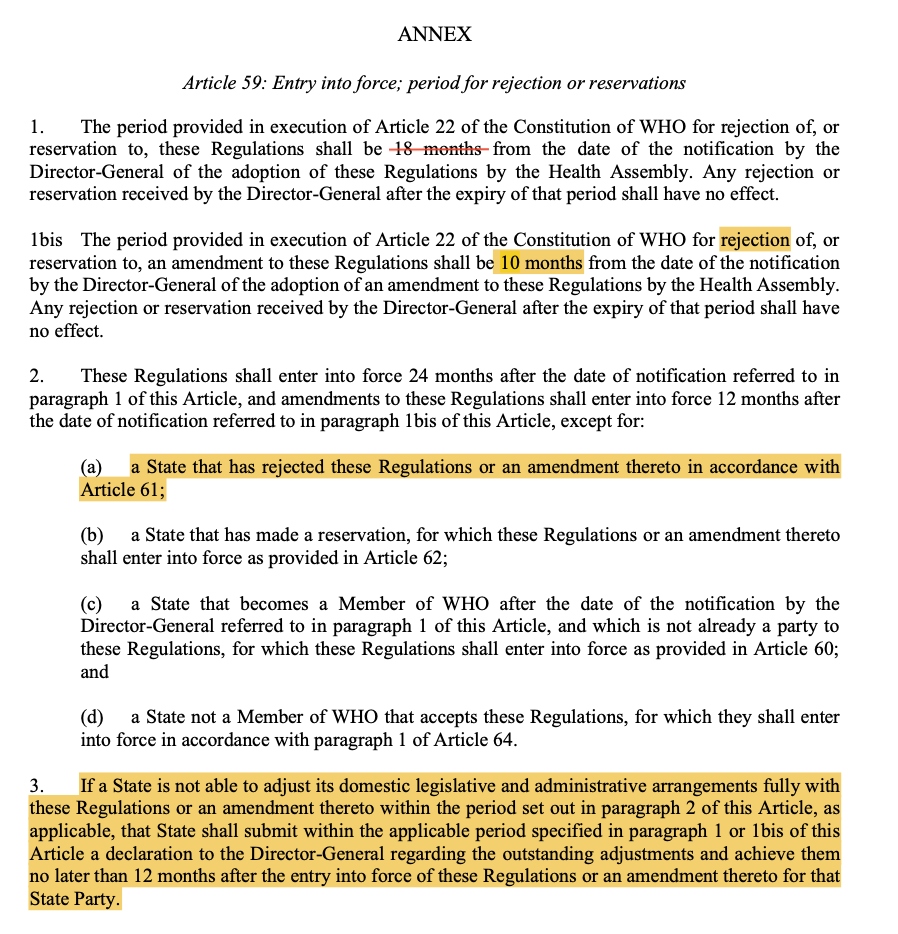
Express rejection of the Article 59 IHRAs by Australia is required by 1 December 2023 (ie within 18 months of the adoption by the WHAand delivery to the member states).
The Article 59 IHRAs are of immediate concern with express rejection being required by 27 November 2023, otherwise the timeframe for rejecting future amendments, the substantial and significant 307 IHRAs, decreases from 18 months to 10 months. This timeframe for a country to consider future IHRAs will be difficult and ambitious, especially where the current version of the 307 IHRs will require significant changes to Australia’s domestic laws.
These binding changes do not require express acceptance: acceptance is by acquiescence as per Article 22 of the WHO’s Constitution, which provides that Regulations adopted “shall come into force for all Members after due notice has been given of their adoption by the Health Assembly”.
Therefore, the only way to reject the proposed IHRAs is to expressly do so, in writing, in accordance with 2005 IHRs Article 59, item 1.
On 3 August 2023, JSCT endorsed the Article 59 IHRAs “as a minor treaty action and that binding treaty action be taken” that “the amendments are expected to have negligible legal, financial, or practical impact on Australia”.
JSCT considered only the Article 59 IHRAs on their own, without reference to any of the other three Treaty documents (which we appreciate are currently being worked on, but are all at stages of significant advancement so as to be informative for JSCT).
B. Concerning proposed amendments in the 307 Proposed IHRAs:
The 307 IHRAs are egregious in their amendments and achieve the above expressed concerns as follows:
1. They cede the sovereignty of every Member State to the WHO in respect to all risks with a potential risk to public health.
Under the current draft of the 307 IHRAs, the WHO is able to determine an international health concern (of the WHO’s choosing) and that the WHO’s standing recommendations will now be BINDING – that is each Member States has to comply. At present the 2005 IHRs expressly state the WHO’s standing recommendations are “non-binding”, ie the WHO’s advice are recommendations only – member states could choose to follow the recommendations or not.
This loss or ceding of sovereignty can be seen in Articles 1, 12, 42, 43 of the 307 IHRAs. In Article 1, the deletion of non-binding’:

This is further clarified in Article 12 by the removal of any right a sovereign nation has to oppose the declaration of a health emergency within their jurisdiction, see proposed deletion in item 2 (highlighted yellow). By removing the obligation of the Director General to convene an Emergency Committee, and by removing the agreement between the Director General and the Member State. This proposal eliminates the consultation with the Member State party in whose territory the event occurs:
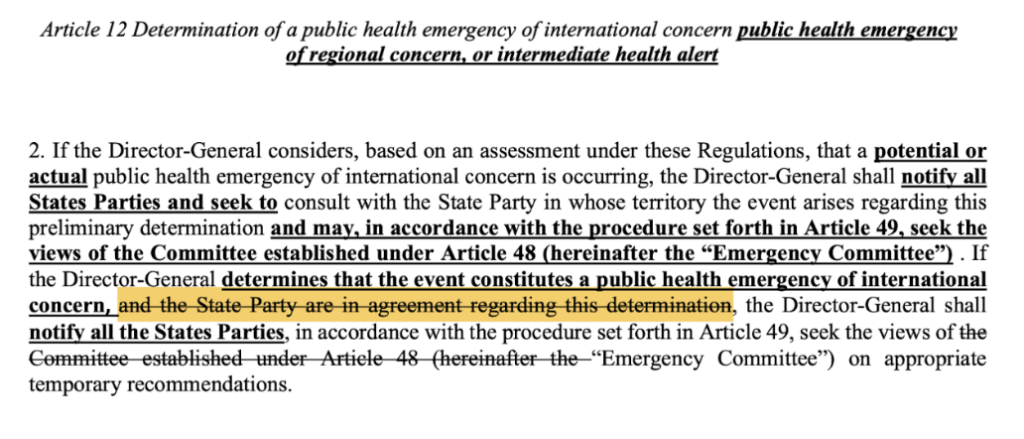
Health recommendations will become legally binding orders per Article 42 of the 307 IHRAs:

With Article 43 confirming the Emergency Committee would be given sovereign authority over all nations:
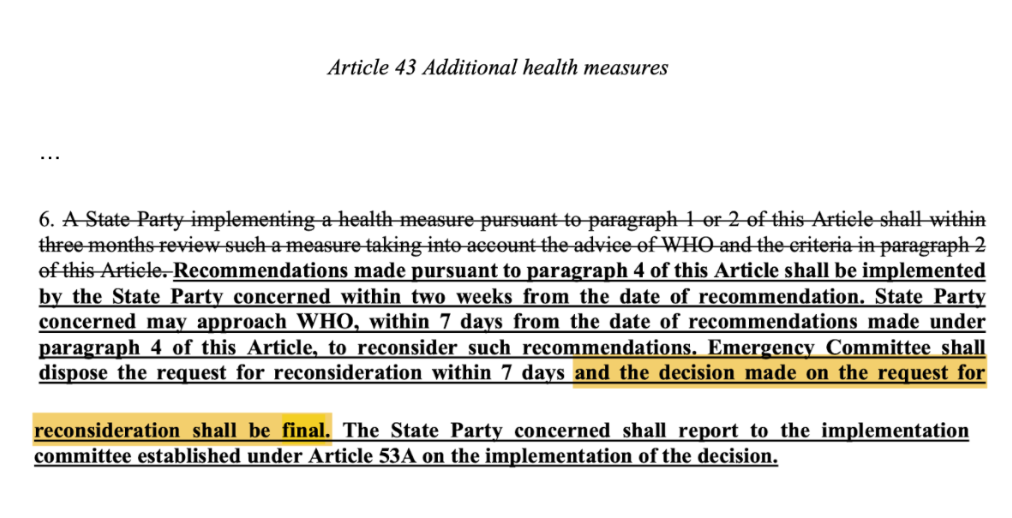
The proposed drafting expands the WHO’s scope to declare an actual health risk to one of potential risk. That is the WHO defines any potential health risk of international concern (that is of the WHO’s choosing). This wording is so loose and could arguably be used for more than a pandemic (eg justification could include climate issues). See Article 2:

2. The 307 IHRA’s remove a focus on individual human rights and choice for the common good concepts of equity and inclusivity. That means the WHO can decide the medical response, including pharmaceuticals and who can take them. We anticipate this will be in the form of mass vaccination campaigns, which the WHO can direct Member States to carry out. See Article 3:

3. The 307 IHRA’s refer to health passports as Digital Passenger Locator Forms, requiring those health passports to detail pathogen test and/or vaccination status, see proposed amendments to Articles 23 and 36:
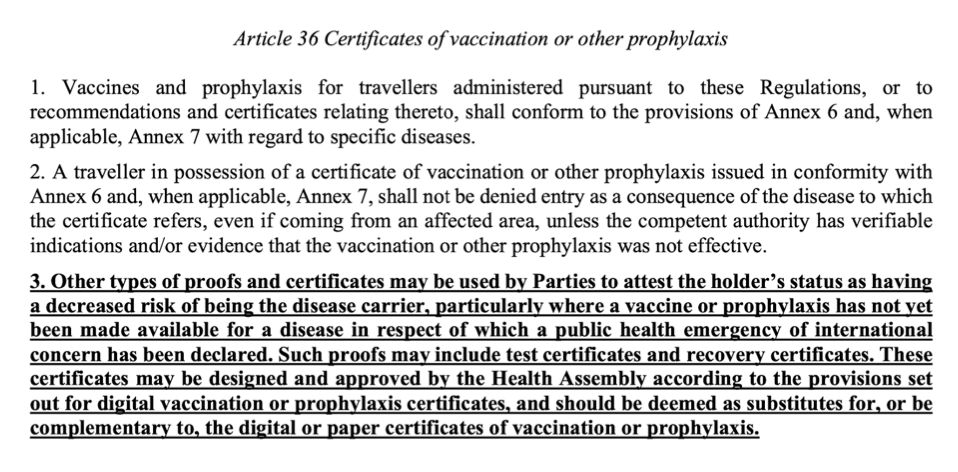
See more information regarding the Global Digital Health Certification Network, available on the:
- WHO’s website: https://www.who.int/initiatives/global-digital-health-certification-network
- WHO’s Global Initiative on Digital Health; and
- The European Commission and WHO launch landmark digital health initiative to strengthen global health security in June 2023; and
- The Eurpoean Parliament and Members States in early November 2024, reached agreement to introduce the Digital Identity
The 307 IHRAs will require Member States are required to supply potential pandemic, personal health information to the WHO, and the WHO has the power to share or withhold any information as it sees fit, see Articles 7 and 11:

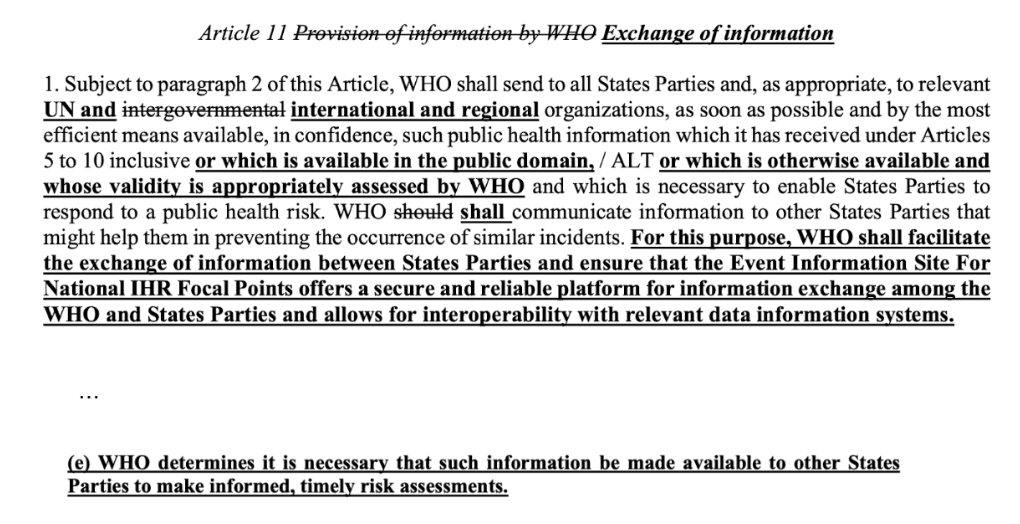
5. There are a number of other amendments in the current draft of the 307 IHRAs where:
- The WHO may direct Member States give money to developing nations – Article 44A
- A new Compliance Committee will be formed- another new committee Article 53
- Expands the powers of each member state’s appointed National IHR Focal Point. Australia already has an unelected appointed National IFR Focal Point, namely the Australian Government Department of Health, National Incident Centre.
As the 307 IHRAs are still being worked on, we will keep you updated.
The WHO CA+ is an entirely new document that purports to be a treaty but its latest iteration actually calls it what it is: “Proposal for negotiating text of the WHO Pandemic Agreement”
The Pandemic Treaty/WHO CA+ is an entirely new convention agreement, which establishes a framework for the identification, tracking, collection of bacteria and viruses and sets out management of a pandemic and the funding of the WHO by Member States.
The background explanation set out in the June 2023 version of the WHO CA+ gave the reason for the document:
In recognition of the catastrophic failure of the international community in showing solidarity and equity in response to the coronavirus disease (COVID-19) pandemic, the World Health Assembly convened a second special session in December 2021, where it established an Intergovernmental Negotiating Body (INB) open to all Member States and Associate Members (and regional economic integration organizations as appropriate) to draft and negotiate a WHO convention, agreement or other international instrument on pandemic prevention, preparedness and response, with a view to its adoption under Article 19, or under other provisions of the WHO Constitution as may be deemed appropriate by the INB.(emphasis added)
These are incredibly powerful and emotive words used to justify the implementation of this convention agreement, especially as there has been no pause for reflection, inquiry or report into the successes and failings of the last 3.5 years.
The latest version of the WHO CA+ has removed this background in the latest version dated 30 October 2023.
The Pandemic Treaty/WHO CA+ reads more like a trade agreement than a health treaty it:
- Sets up an international supply networks which will be overseen by the WHO.
- Outlines the funding structures and processes including Member States to pay ≥5% of their national health budgets, which will be ‘devoted to health emergencies’.
- Sets up a new ‘Governing Body,’ under the auspices of the WHO auspices, to oversee the whole process.
- Expands the scope of the ‘One Health’ agenda.
So what are some of the most egregious things proposed in the Pandemic Treaty/WHO CA+?
1. Equity and inclusivity and the One Health approach
A One Health, approach, as opposed to individual human rights and freedoms to choose are one of the core constructs throughout the proposed documents but clearly articled throughout the Pandemic Treaty/WHO CA+.
See Articles 1 (definition), Article 5, with One Health:


2. Outlines public health surveillance, including to test and collect all sorts of pathogens and store them in a central location




3. Specify the amounts of money Member States must pay the WHO to establish this infrastructure for the WHO
See Article 20 regarding Financing (see part):

4. Control the information and the narrative
It does this by dropping the conditions for public funding of R&D in Article 9, while simultaneously curtailing free speech and also supplying the information. Check out Article 1 definition of infodemic, Article 18 re containing mis and disinformation (sound similar to the proposed Misinformation Bill being proposed in Australia and elsewhere around the world), followed by Article 21 which is a panel of experts.
Article 1 – definition, and Articles 18, 23, and 21



6. Limit liability to the vaccine companies through indemnification and establish vaccine injury compensation schemes
The Pandemic Treaty/WHO CA+ under the guise of liability risk management is not proposed for the purposes of fairly compensating the injured, rather to protect the pharmaceutical manufacturers by setting compensation schemes, ensuring indemnity provisions in vaccine supply contracts, reducing liability for ‘pandemic related products and changing the laws of the Member State making the above referred publicly available.

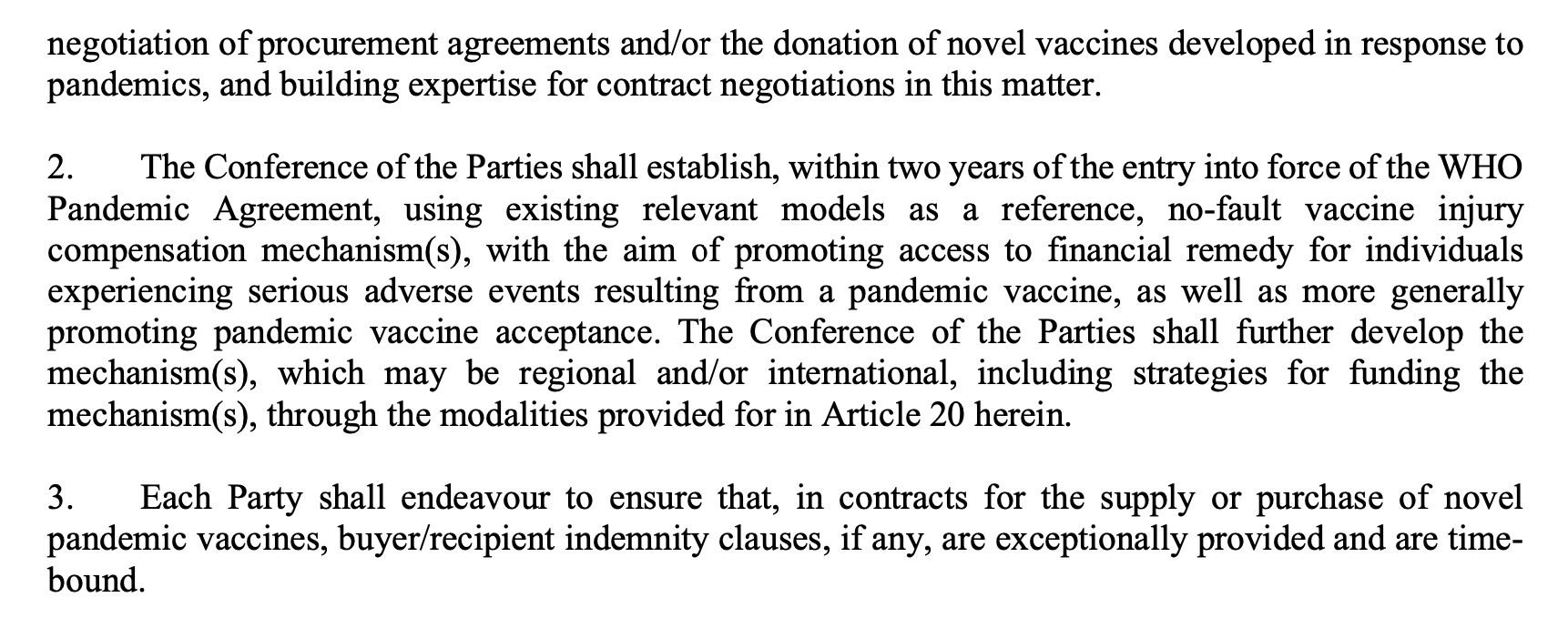
9. What are our representatives and Ministers telling us?
As the Proposed IHRAs are amendments and not a new treaty, it is possible the amendments to the IHRs will be passed through Cabinet’s parliamentary treaty examination processes.
After the last 4 years, the above fail to give any comfort or assurances, that things are not already well in motion for the WHO to be granted significant further power under the Proposed IHRAs.
When these issues are raised, we are regularly reassured that:
“Any changes to Australian law to implement the new instrument or IHR amendments would also have to be considered and passed by Parliament. Similarly, the Australian Constitution can only be changed by referendum, which requires a public vote by the people of Australia in accordance with the requirements of section 128 of the Constitution.”
We appreciate and understand the position being advanced. However, the reassurances are, with respect, disingenuous. By acquiescing to the 307 IHRAs and/or becoming a party to the WHO CA+, Australia will be promising to implement what it has agreed to in those international instruments. It is important to acknowledge that in giving those promises Australia is pledging to the UN and the WHO, as well as the international community, its intention to ratify and enshrine those instruments in our domestic law. It is also important to ask the question; what would be the consequences of our failure to do so?
Further, when making new laws, or amending existing ones, Parliament (both current and future) have a positive onus to take into account all international covenants, treaties and instruments Australia is a party to. If Australia is a party to the 307 IHRAs and the WHO CA+, how could Parliament selectively choose to legislate what international instruments it has agreed to?
This is why these Treaties cause concern, and why these concerns cannot be ignored.
10. What can YOU do about the WHO?
Talk to people, ask them if they’re aware of the international vaccine pass requirements – anticipated for implementation globally [with all Member States] possibly as early as May 2024.
Invite them to check out this page if they’re interested to know the facts. The propaganda runs deep with organisations with online and main steam media running articles that endeavour to dispel the loss of sovereignty and the indoctrination of health enslavement.
Write to your MPs and Senators. A contact list can be found here.
Inform your Senators and MPs by providing them the PPPR Manifesto, the Proposed IHRAs: Article 59 IHRAs, and 307 IHRAs the publicly available version of thePandemic Treaty/WHO CA+. Feel free to share this page with them and to use any of this information on this web page or linked herein.
Encourage your Senators and MPs to lobby together to reject the proposed IHRAs. Rejecting the binding nature of the proposed IHR amendments doesn’t mean we don’t have to follow the WHO’s recommendations, we could simply make the choice to or not to.
Rejecting the Pandemic Treaty/WHO CA+ means that we can choose to comply with and provide the information sought.
Our government must be held accountable – they are the organisation which has to apply the checks and balances that are in place to avoid unbridled power being wielded over us by unelected officials and questionable commercial interests.
These proposed changes, if adopted, will be binding on member states rather than voluntary guidance as they have been up until now. New Zealand and Australia are Member States.

